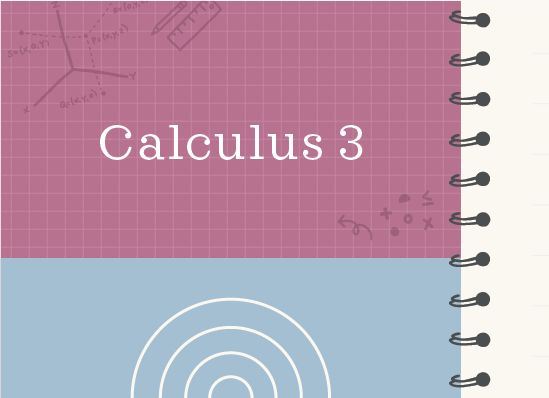Directional derivatives in the direction of the vector
Directional derivatives for two- and three-variable functions
The directional derivative of a multivariable function takes into account the direction (given by the unit vector ???\vec{u}???) as well as the partial derivatives of the function with respect to each of the variables.
Hi! I'm krista.
I create online courses to help you rock your math class. Read more.
In a two variable function, the formula for the directional derivative is
???D_uf(x,y)=a\left(\frac{\partial{f}}{\partial{x}}\right)+b\left(\frac{\partial{f}}{\partial{y}}\right)???
where
???a??? and ???b??? come from the unit vector ???\vec{u}=\langle{a,b\rangle}???
If asked to find the directional derivative in the direction of ???\vec{v}=\langle{c},d\rangle???, we’ll need to convert ???\vec{v}=\langle{c},d\rangle??? to the unit vector using
???\vec{u}=\left\langle\frac{c}{\sqrt{c^2+d^2}},\frac{d}{\sqrt{c^2+d^2}}\right\rangle ???
???\frac{\partial{f}}{\partial{x}}??? is the partial derivative of ???f??? with respect to ???x???
???\frac{\partial{f}}{\partial{y}}??? is the partial derivative of ???f??? with respect to ???y???
In a three variable function, the formula for the directional derivative is
???D_uf(x,y,z)=a\left(\frac{\partial{f}}{\partial{x}}\right)+b\left(\frac{\partial{f}}{\partial{y}}\right)+c\left(\frac{\partial{f}}{\partial{z}}\right)???
where
???a???, ???b??? and ???c??? come from the unit vector ???\vec{u}=\langle{a,b,c\rangle}???
If asked to find the directional derivative in the direction of ???\vec{v}=\langle{d},e,f\rangle???, we’ll need to convert ???\vec{v}=\langle{d},e,f\rangle??? to the unit vector using
???\vec{u}=\left\langle\frac{d}{\sqrt{d^2+e^2+f^2}},\frac{e}{\sqrt{d^2+e^2+f^2}},\frac{f}{\sqrt{d^2+e^2+f^2}}\right\rangle ???
???\frac{\partial{f}}{\partial{x}}??? is the partial derivative of ???f??? with respect to ???x???
???\frac{\partial{f}}{\partial{y}}??? is the partial derivative of ???f??? with respect to ???y???
???\frac{\partial{f}}{\partial{z}}??? is the partial derivative of ???f??? with respect to ???z???
How to find the directional derivatives in the direction of a given vector
Take the course
Want to learn more about Calculus 3? I have a step-by-step course for that. :)
The directional derivative toward a vector at a particular point
Example
Find the directional derivative of ???f(x,y)??? in the direction of ???\vec{v}=\langle1,2\rangle??? at the point ???P(1,-2)???.
???f(x,y)=2x^3+3x^2y+y^2???
We’ll start by converting the given vector to its unit vector form.
???\vec{u}=\left\langle\frac{c}{\sqrt{c^2+d^2}},\frac{d}{\sqrt{c^2+d^2}}\right\rangle ???
???\vec{u}=\left\langle\frac{1}{\sqrt{(1)^2+(2)^2}},\frac{2}{\sqrt{(1)^2+(2)^2}}\right\rangle ???
???\vec{u}=\left\langle\frac{1}{\sqrt{5}},\frac{2}{\sqrt{5}}\right\rangle ???
Now we’ll find the partial derivatives of ???f??? with respect to ???x??? and ???y???.
???\frac{\partial{f}}{\partial{x}}=6x^2+6xy???
and
???\frac{\partial{f}}{\partial{y}}=3x^2+2y???
The directional derivative of a multivariable function accounts for the direction and the partial derivatives of the function with respect to each variable.
With the unit vector and the partial derivatives, we have everything we need to plug into our formula for the directional derivative.
???D_uf(x,y)=\frac{1}{\sqrt{5}}\left(6x^2+6xy\right)+\frac{2}{\sqrt{5}}\left(3x^2+2y\right)???
We want to find the directional derivative at the point ???P(1,-2)???, so we’ll plug this into the equation we just found for the directional derivative, and we’ll get
???D_uf(1,-2)=\frac{1}{\sqrt{5}}\left[6(1)^2+6(1)(-2)\right]+\frac{2}{\sqrt{5}}\left[3(1)^2+2(-2)\right]???
???D_uf(1,-2)=\frac{-6}{\sqrt{5}}+\frac{-2}{\sqrt{5}}???
???D_uf(1,-2)=\frac{-8}{\sqrt{5}}???
This is the directional derivative of the function ???f(x,y)=2x^3+3x^2y+y^2??? in the direction ???\vec{v}=\langle1,2\rangle??? at the point ???P(1,-2)???.






